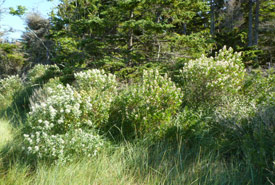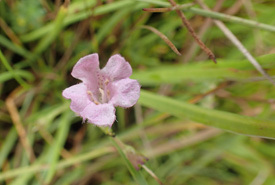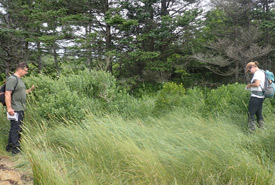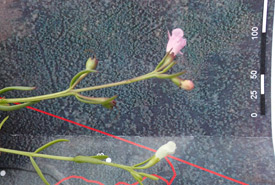What's in a salt marsh?

Wilson Lake and Lobster Bay, NS (Photo by Anthony Crawford)
My field work for the Nature Conservancy of Canada (NCC) often takes me through a number of different habitats, including salt marshes. Some are big, some are small, most are just right. One of these salt marshes is located in Yarmouth County, Nova Scotia on an island called Roberts Island, which is connected to mainland Nova Scotia by a small bridge. On this island is a property that NCC has recently acquired, which includes forested habitat, freshwater wetland habitat and yes, a very nice salt marsh.
Why is this a very nice salt marsh you ask? Well, like other salt marshes it contributes to shoreline stabilization, intercepts run-off that carries with it excessive nutrients and contaminants, contributes to marine and coastal food webs and provides protection from flooding and storm surges.

Agalinis Maritima flower, Lobster Bay, NS (Photo by NCC)
This specific salt marsh is part of a larger unfragmented salt marsh complex that is approximately 37 acres (15 hectares) in size and hosts eastern baccharis and saltmarsh agalinis (also called saltmarsh false foxglove) – both rare species restricted to salt marsh habitat.
Eastern baccharis is a shrub in the aster family only found in a 25-kilometre-wide region along the coast in southwestern Nova Scotia, Canada. It is a disjunct species, meaning its next closest occurrence is in Massachusetts.

Eastern baccharis, Lobster Bay, NS (Photo by NCC)
That’s a big gap and this means that the eastern baccharis in Nova Scotia is at the northernmost edge of its extent. The species is only able to survive on Nova Scotia’s harsh coast because it is located at the southernmost edge of Nova Scotia, where the oceanic currents moderate the climate; resulting in warmer winters than elsewhere in Nova Scotia.
These oceanic currents, along with other factors, mean these salt marshes are part of a highly productive ecosystem.

Agalinis maritima from Lobster Bay, NS (Photo by NCC)
The saltmarsh agalinis is a lot smaller than the eastern baccharis — only reaching 30 centimetres tall. But in Canada, it can also only be found in these productive salt marshes in Yarmouth County.
This is one of the reasons why NCC is working hard in southwestern Nova Scotia to protect these amazing salt marshes that support ecosystem functions and a diversity of species, including rare flora species that don’t exist elsewhere in Canada. And that’s why we focus on protecting habitats – we’re increasing the resiliency of ecosystems and we’re protecting spaces for a diversity of species to flourish.
Sometimes, when we wander through these places we find the unexpected – like the eastern baccharis and saltmarsh agalinis.


